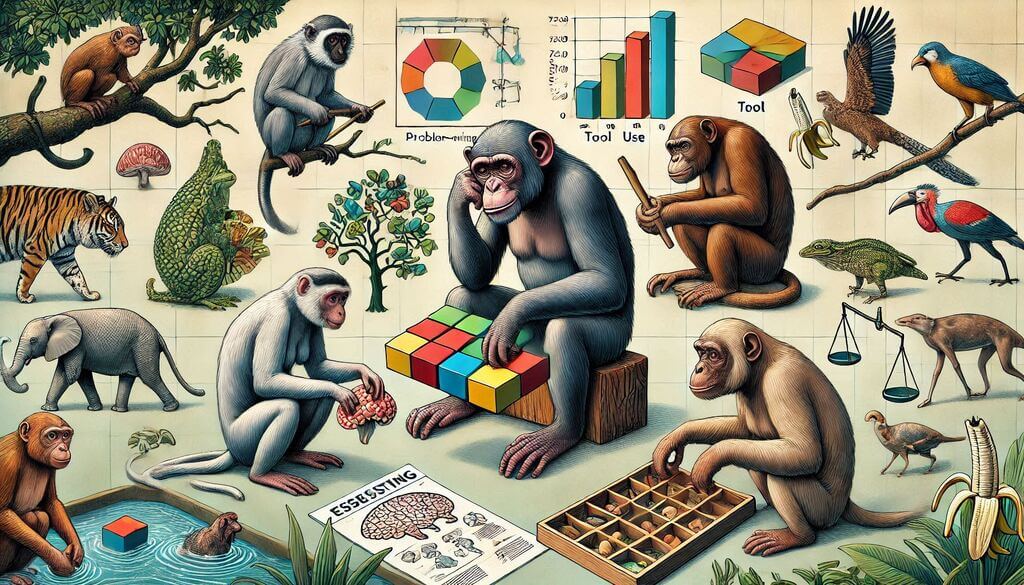
Introduction
Animal cognition refers to the mental capacities of non-human animals, including their ability to perceive, think, learn, and solve problems. The study of animal cognition encompasses a broad range of behaviors, with problem-solving and tool use being two critical areas of focus. These behaviors not only reveal the complexity of animal minds but also provide insights into the evolutionary pathways that shape cognitive abilities across different species.
Understanding Animal Cognition
Cognition in animals can be defined as the mental processes involved in acquiring knowledge and understanding through thought, experience, and the senses. This encompasses a range of abilities such as perception, memory, reasoning, and problem-solving. Researchers assess animal cognition through various methods, including behavioral experiments, observational studies, and comparative analyses across species.
1. Defining Problem-Solving
Problem-solving is the process of identifying solutions to obstacles that hinder an organism from achieving a goal. This ability can be seen in various contexts, from finding food and shelter to navigating complex environments. Problem-solving can be categorized into two main types:
Trial-and-Error Learning: This involves exploring different solutions to a problem until a successful outcome is achieved. This method is often seen in animals that have a higher degree of flexibility in their behavior.
Insight Learning: This more advanced form of problem-solving involves the sudden realization of a solution to a problem, often without the need for trial-and-error. Insight learning suggests a higher level of cognitive processing and understanding of the situation.
2. Tool Use: An Indicator of Cognitive Ability
Tool use is defined as the ability to use an object to achieve a goal. It is often viewed as a hallmark of advanced cognitive functioning and is linked to problem-solving abilities. Tool use can be classified into several categories:
Simple Tool Use: Involves using an object in its natural state to achieve a goal, such as using a stick to reach food.
Complex Tool Use: Refers to the modification or manufacture of tools to suit specific purposes, demonstrating foresight and planning.
Cultural Tool Use: Involves the transmission of tool-using behaviors within a group, indicating social learning and cultural evolution.
Problem-Solving and Tool Use Across Species
1. Primates
Primates are among the most studied groups in the context of cognition, particularly in problem-solving and tool use.
Chimpanzees
Chimpanzees (Pan troglodytes) have demonstrated remarkable problem-solving skills and advanced tool use. They are known to:
Use Tools for Foraging: Chimpanzees use sticks to extract termites from mounds, using specific tools based on the task at hand. They also use stones to crack nuts, showing the ability to select the right tool for different types of nuts.
Demonstrate Insight: In experimental settings, chimpanzees have shown insight learning, such as solving puzzles that require multiple steps to achieve a goal, like obtaining food.
Capuchin Monkeys
Capuchin monkeys (Cebus apella) are also noted for their cognitive abilities, particularly in tool use.
Diverse Tool Use: Capuchins have been observed using stones to crack open nuts and employing leaves as sponges to soak up water. Their flexibility in tool use demonstrates an understanding of the properties of different objects.
Problem-Solving Skills: These monkeys have shown the ability to learn from watching others, indicating a capacity for social learning and imitation.
2. Birds
Birds, particularly corvids and parrots, exhibit advanced cognitive abilities that rival those of primates.
New Caledonian Crows
New Caledonian crows (Corvus moneduloides) are renowned for their exceptional tool-making skills.
Complex Tool Use: These crows create and use tools from various materials, including twigs and leaves. They demonstrate the ability to shape tools to meet specific challenges, such as fashioning hooks to extract insects from tree bark.
Problem-Solving Abilities: Crows have participated in experiments that require them to solve complex tasks involving multiple steps, showcasing their ability to plan and anticipate outcomes.
African Grey Parrots
African grey parrots (Psittacus erithacus) are known for their high intelligence and problem-solving capabilities.
Tool Use: These parrots can use objects to obtain food and have shown an understanding of causal relationships when interacting with their environment.
Communication and Learning: Their ability to mimic human speech and understand commands further highlights their cognitive sophistication, as they can associate words with actions and objects.
3. Marine Mammals
Marine mammals, including dolphins and sea otters, exhibit advanced problem-solving skills and tool use.
Bottlenose Dolphins
Bottlenose dolphins (Tursiops truncatus) are recognized for their complex social structures and cognitive abilities.
Use of Marine Tools: Dolphins have been observed using marine sponges to protect their rostrums while foraging on the seafloor, showcasing their innovative use of natural objects as tools.
Social Learning: They exhibit problem-solving behaviors in cooperative hunting strategies, where groups of dolphins work together to herd fish into tight balls for easier capture.
Sea Otters
Sea otters (Enhydra lutris) display remarkable tool use in their foraging behavior.
Stone Tools: Sea otters are known to use stones to crack open shellfish, such as clams and sea urchins. They often carry their favorite stones in pouches under their arms for easy access while foraging.
Problem-Solving in Feeding: Their ability to manipulate tools to access food demonstrates both intelligence and dexterity.
4. Insects
While often overlooked, insects also exhibit impressive problem-solving abilities and tool use.
Ants
Certain ant species demonstrate collective problem-solving abilities through their social structures.
Foraging Strategies: Ants can solve complex problems related to resource allocation and navigation through pheromone trails, efficiently coordinating group efforts in finding food.
Tool Use in Leaf-Cutting Ants: Leaf-cutter ants (Atta spp.) can use leaves as tools to cultivate fungus, which serves as their primary food source. This behavior illustrates advanced planning and resource management.
Honeybees
Honeybees (Apis mellifera) showcase problem-solving skills in their foraging and communication.
Communication and Learning: Bees communicate the location of food sources through the "waggle dance," demonstrating their ability to convey complex information to other members of the colony.
Adaptation to Challenges: Research has shown that honeybees can learn to solve puzzles to obtain rewards, indicating cognitive flexibility.
Factors Influencing Animal Cognition
1. Ecological and Evolutionary Pressures
The cognitive abilities of animals are influenced by various ecological and evolutionary factors, including:
Environmental Complexity: Species that inhabit more complex environments tend to develop advanced cognitive abilities as they navigate challenges associated with finding food, shelter, and mates.
Social Structures: Animals living in complex social groups often require higher cognitive skills to navigate relationships, communicate effectively, and cooperate with others.
Survival Needs: Problem-solving and tool use often emerge in response to specific survival challenges, such as finding food or avoiding predators.
2. Brain Size and Structure
The relationship between brain size and cognitive abilities has been a subject of interest in understanding animal cognition.
Encephalization Quotient (EQ): The EQ is a measure of brain size relative to body size and is often used to predict cognitive abilities. Higher EQ values are associated with more advanced cognitive skills.
Neuroanatomy: The structure of the brain, including the development of specific regions associated with learning and memory, also plays a role in determining cognitive capabilities.
3. Learning and Memory
Learning and memory are critical components of animal cognition, influencing problem-solving abilities and tool use.
Social Learning: Many species rely on social learning to acquire new skills and behaviors, particularly those involving tool use. Observing others can enhance individual problem-solving abilities.
Cognitive Flexibility: The ability to adapt learned behaviors to new situations is an important aspect of problem-solving. Animals that exhibit cognitive flexibility are better equipped to face novel challenges.
Assessing Animal Cognition: Methodologies
Researchers employ a variety of methodologies to assess animal cognition, focusing on problem-solving and tool use.
1. Experimental Studies
Experimental studies often involve controlled conditions to evaluate cognitive abilities.
Problem-Solving Tasks: Animals are presented with puzzles or tasks that require them to demonstrate their problem-solving skills, such as retrieving food using tools or navigating mazes.
Tool Use Experiments: Researchers design experiments to test whether animals can use tools effectively to achieve goals. These studies can involve providing animals with various tools and observing their behavior.
2. Observational Studies
Observational studies allow researchers to assess cognitive abilities in natural settings.
Field Studies: Researchers observe animals in their natural habitats, documenting their behaviors related to problem-solving and tool use in real-world contexts.
Longitudinal Studies: Long-term studies provide insights into how cognitive abilities develop over time and how experiences shape problem-solving skills.
3. Comparative Analyses
Comparative analyses involve studying different species to understand evolutionary trends in cognition.
Phylogenetic Studies: By examining the cognitive abilities of various species across the animal kingdom, researchers can identify patterns of evolution and adaptation related to problem-solving and tool use.
Cross-Species Comparisons: Comparing cognitive abilities among closely related species can shed light on the factors driving the evolution of intelligence and cognitive skills.
Implications of Animal Cognition Research
The study of animal cognition has significant implications for various fields, including
conservation biology, animal welfare, and understanding human evolution.
1. Conservation Biology
Understanding animal cognition can inform conservation strategies by recognizing the cognitive needs of species.
Habitat Protection: Cognitive capabilities play a role in how species interact with their environment. Protecting habitats that support cognitive development is crucial for maintaining populations.
Behavioral Enrichment: For captive animals, providing opportunities for problem-solving and tool use can enhance their well-being and reduce stress.
2. Animal Welfare
Research on cognition can lead to improved welfare standards for animals in captivity.
Understanding Needs: Recognizing the cognitive capacities of animals helps caregivers provide appropriate stimulation and enrichment that cater to their mental abilities.
Reducing Boredom and Stress: Enriched environments that encourage problem-solving and exploration can mitigate behavioral issues associated with boredom.
3. Insights into Human Evolution
Studying animal cognition can also provide insights into the evolution of human intelligence.
Comparative Cognition: Understanding the cognitive abilities of other species allows researchers to identify the evolutionary origins of human cognition and the factors that contributed to the development of advanced intelligence.
Cognitive Continuum: Recognizing that cognitive abilities exist along a continuum across species challenges the notion of a strict divide between human and non-human intelligence.

